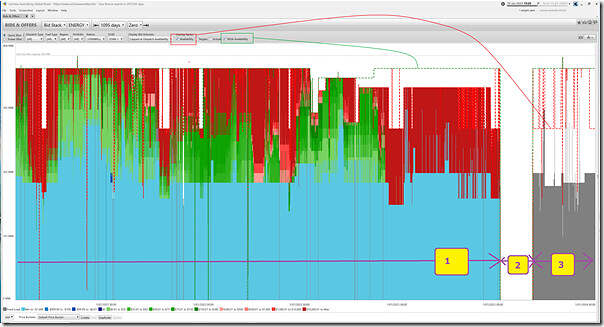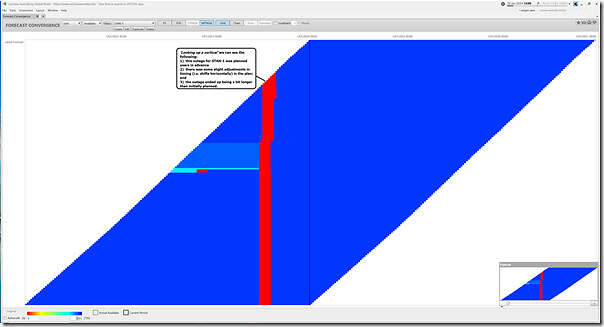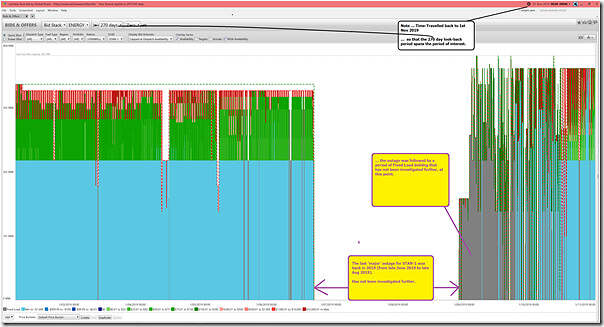There are 44 coal units still operational in the NEM … and these units are continuing to supply a large share of the total volume of energy consumed in the NEM.
Switching focus from VIC to QLD
Yesterday I posted about some recent ‘Hiccups at Loy Yang A4’.
In today’s article we turn our attention further north to the Stanwell unit 1 (STAN-1 is the DUID), because there’s something that’s been happening there which has been the subject of an email chain that I have been tagged into:
1) Remembering that the Stanwell units are, historically, some of the better performing coal units across the broader fleet
2) However with respect to what’s been happening recently, I have more questions than answers at this point.
Here’s a quick look back (via the ‘Bids & Offers’ widget in ez2view) to how the unit has been bidding into AEMO over the past 3 years:
I’ve chosen to look back three years as there are, quite clearly, three distinct time ranges shown in this chart pertaining to this particular unit:
Time Range #1 (until 15th July 2023)
In the first time range we see a long* history of continuous operation that’s excellent for any unit.
1) Note that the chart above(*) starts at January 2021, but we actually need to go back to 5th August 2020 to see the last time when the unit was offline for a long outage (back then only ~ 2 week ‘minor’ outage).
2) Unless I have missed some minor outage or trip over that time range, I think this means that STAN-1 unit would have achieved 1,073 days of continuous operation through that period!
That’s mighty impressive … I had thought there might be some news release about this long service period on the Stanwell news site (or in a media statement), but I could not see it when I scanned.
… the outage (below) was referenced in this note on 10th July 2023 and this note on 9th January 2024.
In terms of the bids over the time range, these naturally vary over that time in relation to a wide range of variables (inside the station and outside the station). But the three generic colour bands used in the ‘Bids & Offers’ widget in ez2view makes it easy to see:
Range #1 ) In BLUE = the volume offered at or below $0/MWh
(a) including, in much of the time range above, down at the -$1,000/MWh Market Price Floor
(b) to indicate that the unit would rather pay to generate rather than be dispatched off.
Range #2 ) In GREEN = the volume offered between $0/MWh and $300/MWh the volume
… being the traditional Short Run Marginal Cost bid ranges (units often use more than just one, and also tend to take into account shadow SRMC for the next-most-expensive generators, etc…)
Range #3 ) In PINK and RED = above the $300/MWh ASX Cap trigger price, all the way up to the Market Price Cap (which has varied over that time range).
Time Range #2 (15th July 2023 to 14th Sept 2023)
In the second period there’s no volume offered to the market … this was a planned outage, long known in advance. We can see this clearly in this snapshot from the ‘Forecast Convergence’ widget in ez2view, showing the MT PASA DUID Availability data filtered down just to the STAN-1 unit:
Remember that you can use this widget to ‘look up a vertical’ and see ‘that other dimension of time’.
As noted on the image, we can see each of the following:
1) this outage for STAN-1 was planned years in advance
2) there was some slight adjustments in timing (i.e. shifts horizontally) in the plan; and
3) the outage ended up being a bit longer than initially planned.
… but all so far so good.
Time Range #3 (14th Sept 2023 to NOW)
Following from the outage, the unit was first back online on 14th September 2023.
1) Since that time, it’s been bidding ‘Fixed Load’.
2) During this period:
(a) The PASA Avail has been consistently bid at 365MW (which is the stations Registered Capacity – and remembering that this is a better measure of ‘Installed Capacity’ for many of the coal units).
(b) However over that period, the Bid MaxAvail has varied a bit, but commonly been 270MW
(c) Even further below that, the Fixed Load bid has been most often at levels like 200MW, 180MW, 185MW.
3) A number of Daily Bids, starting on 15th September 2023, have Reasons like …
(a) ‘fixed load required to manage HPBV pipework’
(b) ‘manage HP bypass pipework stress’
(c) ‘HP bypass pipework fatigue’
… or similar
4) Now my ‘real engineering’ knowledge is decades old and rusty, but:
(a) I think HPBV stands for High Pressure Bypass Valve?
(b) It’s not a part of the plant that is normally in use … which just leaves me with questions; and
(c) I do specifically recall that concerns about fatigue (and creep) damage in high temperature/pressure components is of particular concern in any power stations that involve combustion and/or a steam cycle (it was the focus of my ES Cornwall scholarship in the 1990’s).
Perhaps some readers can help us understand more about what the situation is at Stanwell unit 1?
An earlier time range (June to August 2019 and afterwards)
Interestingly, looking back to the last major outage for the unit (June to August 2019), after the unit came back online there was also a period of running at Fixed Load:
1) which is shown here (via the ‘Bids & Offers’ widget in ez2view in Time Travel),
2) but not further investigated:
That’s all for now …





How does the bidding fixed load works? I presume it is required for plant restoration times. will the generator be exposed to any market price risks when bided fixed load?
Stacked under the bids down at -$1,000/MWh in the NEMDE dispatch process, Selva … easiest to think about it as a ‘must run, for technical reasons … I will take any price’ bid.
Commonly used in testing scenarios, and on other occasions like this.
A HPBV is an “optional extra” on a unit intended to permit the unit to survive a major load rejection without tripping the boiler. Basically HP steam is bypassed directly to the unit condenser rather than through the turbine. Not intended for extended use but to manage transients and also assist in start up. Now it is interesting that it is Stanwell 1 – the first unit of what was then Australia’s first heavily automated coal fired station. As such it probably went through lots of start up , shut down and testing cycles during commissioning. Creep is a function of temperature/ pressure and time whereas fatigue can have a few causes. This one is likely to be a result of rapid temperature changes to the pipework around the valve when it opens in anger. Probably has a bit more accumulated use from being unit 1. Probably found an issue when performing metallurgical inspections during their outage (eg a crack or similar). This will now be being managed by making sure the HPBV does not need to operate by (maybe) running at less than full boiler pressure (hence reduced output) and limiting governor action (constant load) until they can get replacement pipework manufactured and get it glued in (no small undertaking). Sounds like good maintenance and engineering at work. Pleasing to see the guys are on top of their plant.
Thanks for helping readers out with some more context, Andy.
Along the same lines, worth reminding readers that Stanwell has TTHL (trip to house load) capability:
1) Which (if my scratchy memory serves me correctly) would be using HP bypass
2) Tested regularly as part of their black start contract, but also used ‘in anger’ on occasions, such as following Callide C4 catastrophe on 25th May 2021 as Allan noted here afterwards.
Paul